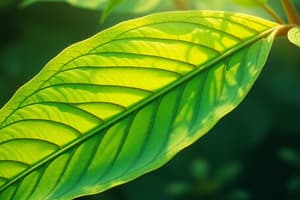Podcast
Questions and Answers
Which layer of a leaf primarily helps in minimizing water loss?
Which layer of a leaf primarily helps in minimizing water loss?
- Spongy mesophyll
- Palisade mesophyll
- Stomates
- Wax cuticle (correct)
What is the primary function of phloem in vascular plants?
What is the primary function of phloem in vascular plants?
- Transmitting hormones only
- Transporting water to the leaves
- Conducting sugars and other organic products (correct)
- Providing structural support to stems
In terms of direction of transport, xylem only moves substances in which direction?
In terms of direction of transport, xylem only moves substances in which direction?
- In a circular motion
- Only up the plant (correct)
- Up and down the plant
- Only down towards the roots
What feature of roots aids in their ability to absorb water efficiently?
What feature of roots aids in their ability to absorb water efficiently?
Which part of the root is responsible for cell division and growth?
Which part of the root is responsible for cell division and growth?
What characteristic distinguishes vascular plants from nonvascular plants?
What characteristic distinguishes vascular plants from nonvascular plants?
How does the structure of stomates facilitate their function?
How does the structure of stomates facilitate their function?
Which of the following statements about the structure of stems is correct?
Which of the following statements about the structure of stems is correct?
The spongy mesophyll primarily serves what function in leaves?
The spongy mesophyll primarily serves what function in leaves?
Which type of energy is used by phloem to transport substances?
Which type of energy is used by phloem to transport substances?
Flashcards are hidden until you start studying
Study Notes
Shoot System
- Leaves primarily function in photosynthesis but are not limited to this role.
- The leaf's structure is designed to facilitate nutrient and material absorption necessary for plant survival.
- Wax Cuticle and Epidermis: These layers minimize evaporation and block bacterial entry into the plant.
- Palisade Mesophyll and Spongy Mesophyll: Contain chloroplasts crucial for conducting photosynthesis.
- Stomates: Located in the epidermis, they manage gas and water exchange.
Stems
- The main role of stems is to transport materials throughout the plant and provide structural support.
- The vascular bundles in stems contain Xylem and Phloem for efficient transport of substances.
- Xylem: Transports water and water-soluble substances upward only.
- Phloem: Conducts sugars, hormones, and other products both upward and downward.
- Structural Differences:
- Xylem has long vessels; Phloem consists of series of sieve plates between cells.
- Energy Requirement: Water transport in xylem is passive, while phloem transport is active.
- Position: Xylem is located on the inner side of vascular bundles, while phloem is on the outer side.
Root System
- Roots anchor the plant to the soil, provide support, and absorb essential mineral ions and water.
- The large surface area (SA) of roots aids in the absorption of required substances, and their pointed shape helps penetrate the soil.
- Root Structure:
- Root Cap: This region is responsible for cell division, facilitating root growth.
- Area of Elongation: Responsible for length growth of roots.
- Area of Maturation: Contains vascular bundles for nutrient transport.
- Root Hairs: Increase surface area to enhance the absorption of nutrients and water.
- Vascular plants have specialized transport systems, whereas nonvascular plants rely on diffusion and osmosis for substance absorption and excretion.
Shoot System
- Leaves primarily function in photosynthesis but are not limited to this role.
- The leaf's structure is designed to facilitate nutrient and material absorption necessary for plant survival.
- Wax Cuticle and Epidermis: These layers minimize evaporation and block bacterial entry into the plant.
- Palisade Mesophyll and Spongy Mesophyll: Contain chloroplasts crucial for conducting photosynthesis.
- Stomates: Located in the epidermis, they manage gas and water exchange.
Stems
- The main role of stems is to transport materials throughout the plant and provide structural support.
- The vascular bundles in stems contain Xylem and Phloem for efficient transport of substances.
- Xylem: Transports water and water-soluble substances upward only.
- Phloem: Conducts sugars, hormones, and other products both upward and downward.
- Structural Differences:
- Xylem has long vessels; Phloem consists of series of sieve plates between cells.
- Energy Requirement: Water transport in xylem is passive, while phloem transport is active.
- Position: Xylem is located on the inner side of vascular bundles, while phloem is on the outer side.
Root System
- Roots anchor the plant to the soil, provide support, and absorb essential mineral ions and water.
- The large surface area (SA) of roots aids in the absorption of required substances, and their pointed shape helps penetrate the soil.
- Root Structure:
- Root Cap: This region is responsible for cell division, facilitating root growth.
- Area of Elongation: Responsible for length growth of roots.
- Area of Maturation: Contains vascular bundles for nutrient transport.
- Root Hairs: Increase surface area to enhance the absorption of nutrients and water.
- Vascular plants have specialized transport systems, whereas nonvascular plants rely on diffusion and osmosis for substance absorption and excretion.
Studying That Suits You
Use AI to generate personalized quizzes and flashcards to suit your learning preferences.




